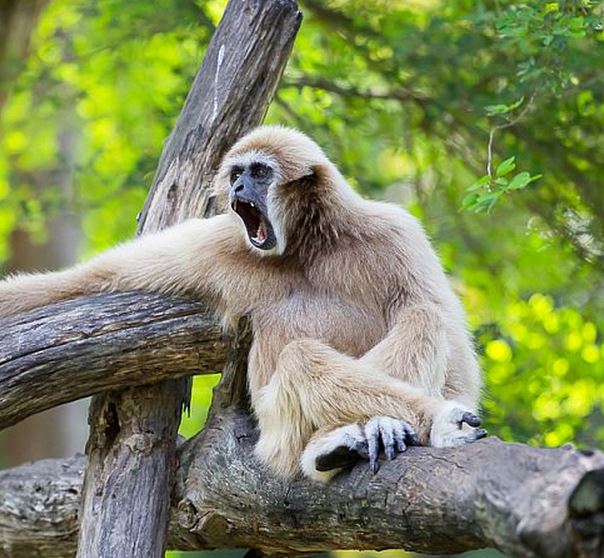Gibbon whisper ‘hoo’ calls have a number of distinct meanings in response to specific events or types of predators, researchers say, adding that their utterances could provide clues on how human speech evolved.
Lar gibbons (Hylobates lar), also known as white-handed gibbons, are famous for their loud and conspicuous vocalizations. However, they can also produce several soft hoo-type calls.
A team of researchers from the US, UK and Switzerland explained in the academic journal BMC Evolutionary Biology (citation below) that gibbons’ subtle calls have often been mentioned in studies dating back more than seventy-five years, but due to their volume, they are virtually indistinguishable to human ears and have been difficult to record and analyse.

The researchers identified 450 different Lar Gibbon ‘hoo’ sounds.
Lead author, Dr. Esther Clarke, a Research Fellow in the Department of Anthropology at Durham University in England, said:
“These animals are extraordinarily vocal creatures and give us the rare opportunity to study the evolution of complex vocal communication in a non-human primate.”
“In the future, gibbon vocalisations may reveal much about the processes that shape vocal communication, and because they are an ape species, they may be one of our best hopes at tracing the evolution of human communication.”
Dr. Clarke, Prof. Ulrich H Reichard from Southern Illinois University, USA, and Klaus Zuberbühler from the Université de Neuchâtel, Switzerland, spent nearly four months following groups of lar gibbons around the forests of north eastern Thailand.
They followed the primates from the first encounter in the morning until they had located their evening sleeping tree, and recorded their hoos and noted the events associated with their utterances.

The verbal communication of gibbons may provide important clues on how human speech evolved.
Gibbons have a wide ‘vocabulary‘
After analyzing the recordings they identified 450 different hoo sounds. They then used computer analysis to link specific audio patterns to the context in which they were recorded.
They found that gibbons had specific hoo calls for a variety of contexts, including predator detection, foraging, encountering neighbours, and as part of their mating songs.
They also discovered subtle hoo variations within specific contexts, for example, to distinguish between different kinds of predator, such as pythons, eagle owls, crested serpent eagles, tigers and clouded leopards.

‘Hoo’ sounds warning about birds of prey were uttered in frequencies raptors were unlikely to hear.
As well as real predator observations, they presented fake model predators in realistic poses for less common animals.
Hoos warning of birds of prey (raptors) were acoustically distinct – shorter, less intense and with a narrower frequency span than other hoos, making them the most difficult to hear. While raptors hear best in the 1kHz to 4 kHz range, gibbon raptor hoos were found to be consistently below the 1kHz threshold.
The researchers believe the raptor hoos were the lowest frequency so that the gibbons could communicate without the predator hearing them.
Leopard and tiger hoos were similar, suggesting that gibbons perceived these two predators as belonging to the same class of ‘bit cats’.
Female gibbons have deeper voices
The authors wrote that gibbon sexes uttered similar hoo calls, with the females producing lower-frequency hoos than the males. This was surprising, because among most mammals, including humans, the male tends to have the deeper voice.
When encountering neighbours, female gibbons tended to keep quiet, while males engaged and interacted vocally with those of other groups.
The research team said their study is directly relevant to the ongoing debate about how human speech evolved. “The ability to produce calls that are context-specific is necessary for communication where an actor refers a recipient’s attention to an external event,” they wrote.
This behavior is widespread and was probably present in the ancient ancestors of modern primates, including humans.
The authors believe the acoustic variation observed in gibbon hoos in particular may be similar to human verbal communication, in which subtle acoustic parameters, such as pitch, can carry meaning.
Citation: “Context-specific close-range “hoo” calls in wild gibbons (Hylobates lar),” Esther Clarke, Ulrich H Reichard and Klaus Zuberbühle. BMC Evolutionary Biology. Published 8 April, 2015. DOI: 10.1186/s12862-015-0332-2.

